tow CADILLAC CATERA 1997 1.G Owners Manual
[x] Cancel search | Manufacturer: CADILLAC, Model Year: 1997, Model line: CATERA, Model: CADILLAC CATERA 1997 1.GPages: 338, PDF Size: 18.02 MB
Page 39 of 338
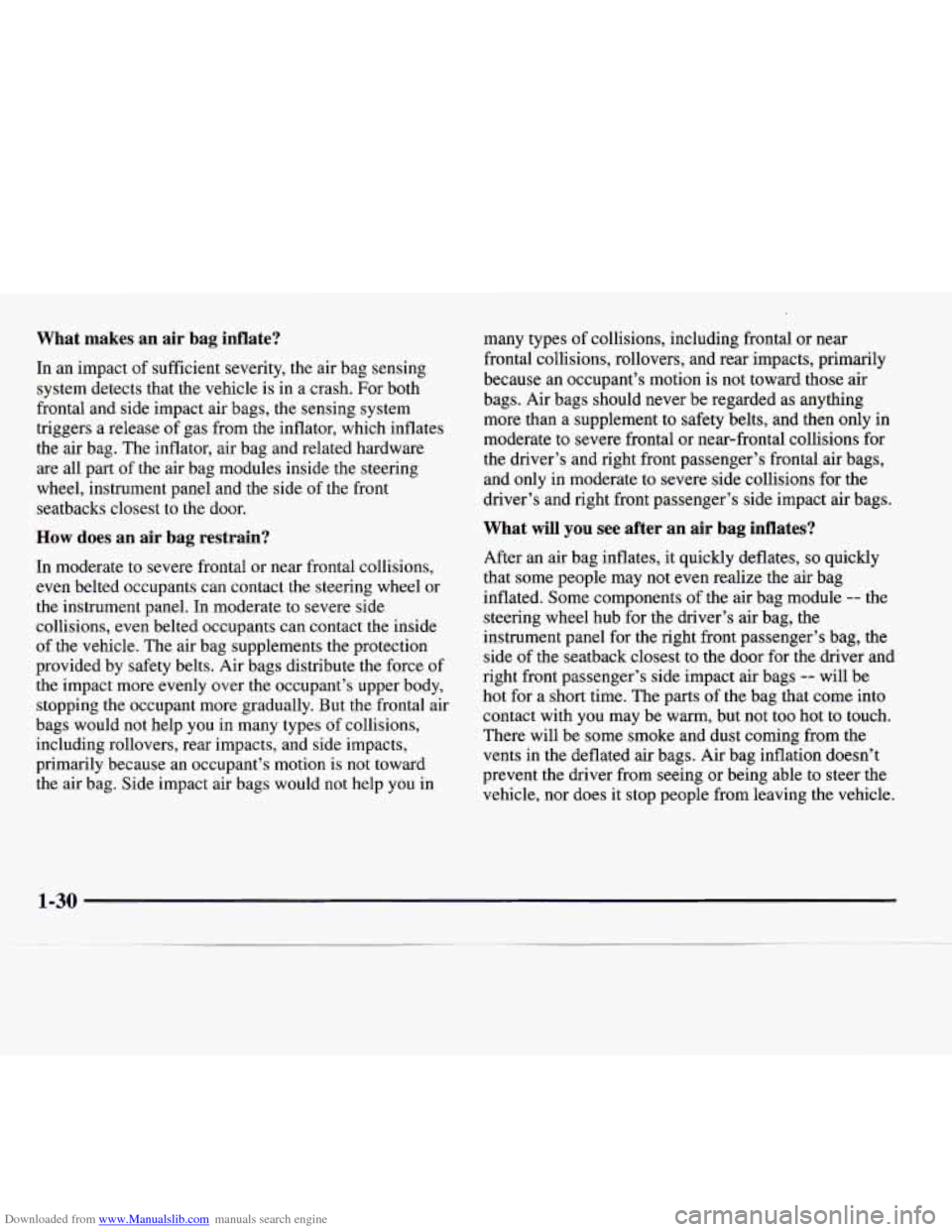
Downloaded from www.Manualslib.com manuals search engine What makes an air bag inflate?
In an impact of sufficient severity, the air bag sensing
system detects that the vehicle is in a crash. For both
frontal and side impact air bags, the sensing system
triggers a release of gas from the inflator, which inflates
the air bag. The inflator, air bag and related hardware
are all part
of the air bag modules inside the steering
wheel, instrument panel and the side of the front
seatbacks closest to the door.
How does an air bag restrain?
In moderate to severe frontal or near frontal collisions,
even belted occupants can contact the steering wheel or
the instrument panel. In moderate to severe side
collisions, even belted occupants can contact the inside
of the vehicle. The air bag supplements the protection
provided by safety belts. Air bags distribute the force of
the impact more evenly over the occupant’s upper body,
stopping the occupant more gradually. But the frontal air
bags would not help you in many types of collisions,
including rollovers, rear impacts, and side impacts,
primarily because an occupant’s motion is not toward
the air bag. Side impact air bags would not help you in many
types of collisions, including frontal or near
frontal collisions, rollovers, and
rear impacts, primarily
because an occupant’s motion is not toward those air
bags. Air bags should never be regarded as anything
more than a supplement to safety belts, and then only in
moderate to severe frontal or near-frontal collisions for
the driver’s and right front passenger’s frontal air bags,
and only in moderate to severe side collisions for the
driver’s and right front passenger’s side impact air bags.
What will you see after an air bag inflates?
After an air bag inflates, it quickly deflates, so quickly
that some people may not even realize the air bag
inflated. Some components of the air bag module
-- the
steering wheel hub for the driver’s air bag, the
instrument panel for the right front passenger’s bag, the
side of the seatback closest to the door for the driver and
right front passenger’s side impact air bags
-- will be
hot for a short time. The parts
of the bag that come into
contact with you may be warm, but not too hot to touch.
There will be some smoke and dust coming from the
vents in the deflated air bags. Air bag inflation doesn’t
prevent the driver from seeing or being able to steer the
vehicle, nor does it stop people from leaving the vehicle.
1-30
Page 57 of 338

Downloaded from www.Manualslib.com manuals search engine Accident statistics show that children are safer if they
are restrained in the rear seat. But they need
to use the
safety belts properly.
Children who aren’t buckled up can be thrown out in
a crash.
Children who aren’t buckled up can strike other
people who are.
F
Never do this.
Here two children are wearing the same belt. The
belt can’t properly spread the impact forces. In
a
crash, the two children can be crushed together
and seriously injured.
A belt must be used by
only one person at a time.
@ What if a child is wearing a lap-shoulder belt,
but the child is
so small that the shoulder belt is
very close to the child’s face or neck?
A: Move the child toward the center of the vehicle, but
be sure that the shoulder belt still is on the child’s
shoulder,
so that in a crash the child’s upper body
would have the restraint that belts provide.
If the
child is
so small that the shoulder belt is still very
close to the child’s face or neck, you might want to
place the child in the center seat position, the one
that has only a lap belt.
1-48
Page 75 of 338

Downloaded from www.Manualslib.com manuals search engine The system works when you turn the key to the
RUN (11) position. The key uses a transponder that
matches an immobilizer control unit in your vehicle.
The correct key will start the vehicle.
When the system senses that someone
is using the
wrong key, it may start but it will not continue
to run. If
someone tries to start your vehicle again or
uses another
key during this time, the shutdown will start over again.
This discourages someone from randomly trying
different keys with different transponders in an attempt
to make a match.
If the engine cannot be started, turn the key in the
ignition
to the RUN (11) position. Wait approximately
two seconds; then start your vehicle again.
If the engine still won’t start, try another key. You may
also want
to check the fuses (see “Fuses and Circuit
Breakers” in the Index). If the engine doesn’t start with
the other key, your vehicle needs service. If your vehicle
does start, the first key may be faulty. See your
Catera dealer.
If you lose or damage a key or you cannot start the
engine, see your Catera dealer.
If a key is lost, bring all
remaining keys
to your dealer for re-programming. In
an emergency, call the Cadillac Roadside Service
Program at 1-800-882-1112.
New Vehicle “Break-In’’
NOTICE:
Your modern Catera doesn’t need an elaborate
“break-in.” But it will perform better in the long
run if you follow these guidelines:
Don’t drive at any one speed -- fast or
slow
-- for the first 500 miles (805 km).
Don’t make full-throttle starts.
200 miles (322 km) or so. During this time
your new brake linings aren’t yet broken
in. Hard stops with new linings can mean
premature wear and earlier replacement.
Follow this breaking-in guideline every
time you get new brake linings.
See “Towing a Trailer” in the Index for
more information.
Avoid making hard stops for the first
0 Don’t tow a trailer during break-in.
2-14
Page 78 of 338
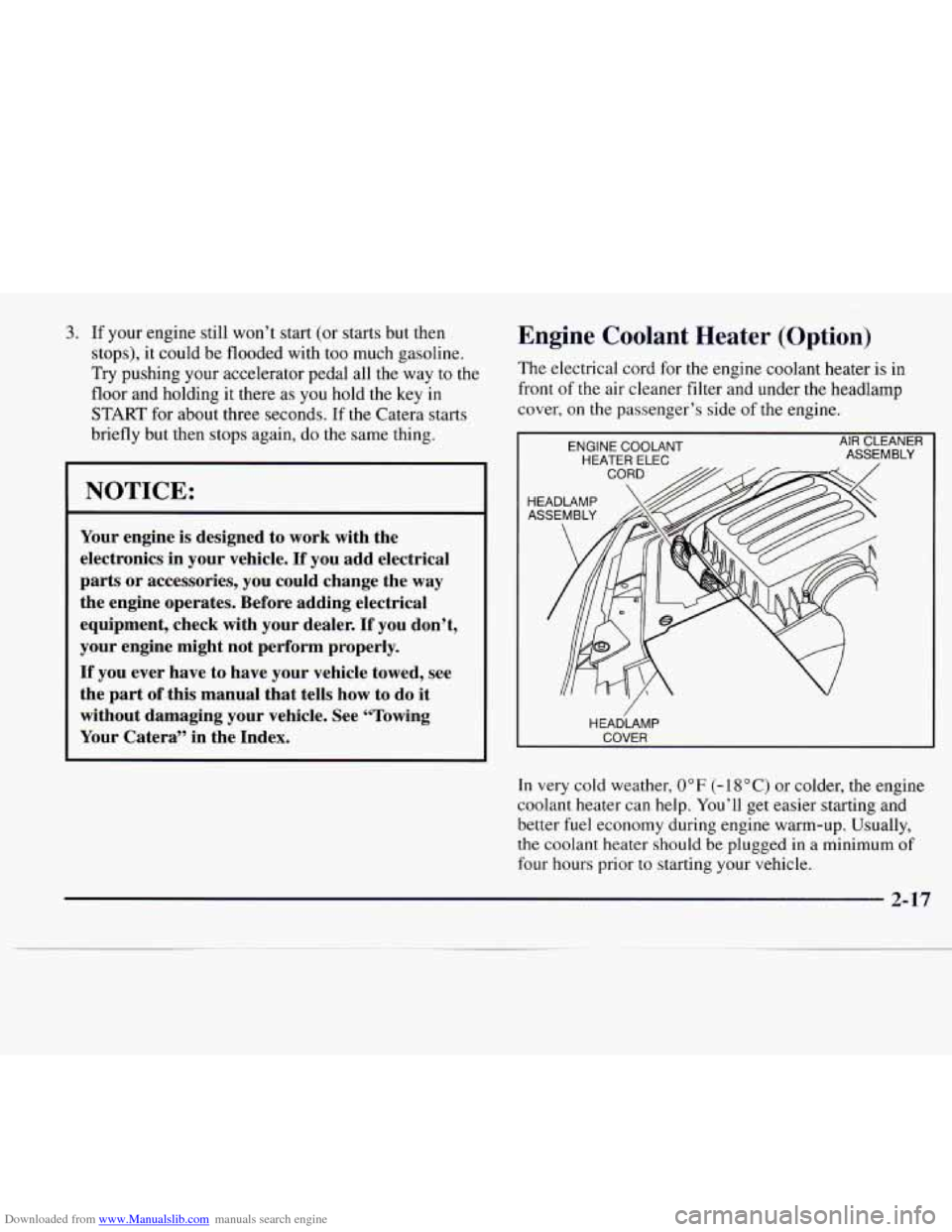
Downloaded from www.Manualslib.com manuals search engine 3. If your engine still won’t start (or starts but then
stops), it could be flooded with too much gasoline.
Try pushing your accelerator pedal all the way to the
floor and holding it there as you hold the key in
START for about three seconds. If the Catera starts
briefly but then stops again,
do the same thing.
I NOTICE:
Your engine is designed to work with the
electronics in your vehicle.
If you add electrical
parts or accessories, you could change the way
the engine operates. Before adding electrical
equipment, check with your dealer.
If you don’t,
your engine might not perform properly.
If you ever have to have your vehicle towed, see
the part of this manual that tells how to do it
without damaging your vehicle.
See “Towing
Your Catera” in the Index.
Engine Coolant Heater (Option)
The electrical cord for the engine coolant heater is in
front of the air cleaner filter and under the headlamp
cover, on
the passenger’s side of the engine.
ENGINE COOLANT
HEATER ELEC AIR CLEANER ASSEMBLY
CORD ////
HE
AS
I
HEADLAMP
COVER
In very cold weather, 0°F (- 18 “C) or
colder, the engine
coolant heater can help. You’ll get easier starting and
better
fuel economy during engine warm-up. Usually,
the coolant heater should be plugged in a minimum of
four hours prior to starting your vehicle.
Page 80 of 338
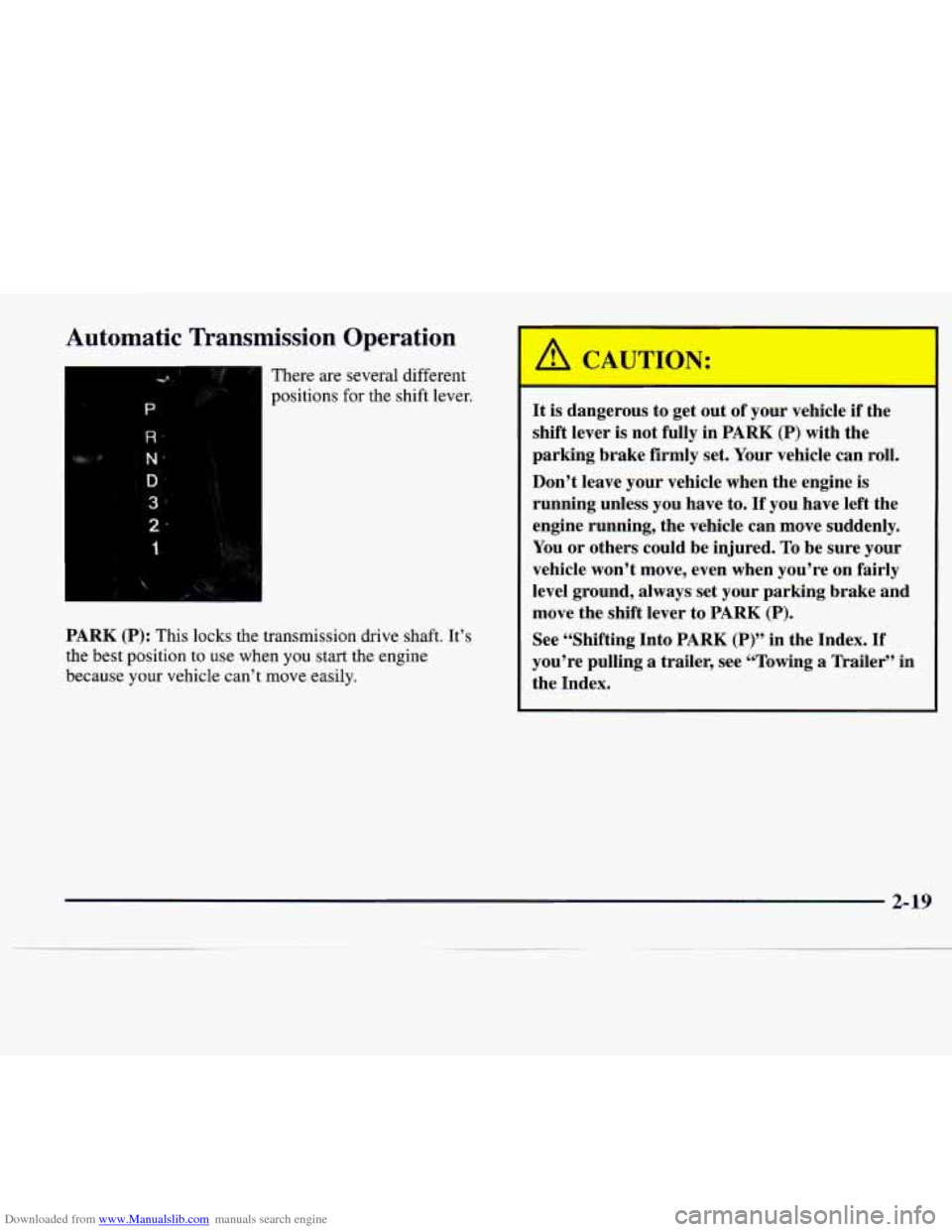
Downloaded from www.Manualslib.com manuals search engine Automatic Transmission Operation
There are several different
positions for
the shift lever.
2-
PARK (P): This locks the transmission drive shaft. It’s
the best position to use when you start the engine
because your vehicle can’t move easily.
A CAUTION:
I
It is dangerous to get out of your vehicle if the
shift lever
is not fully in PARK (P) with the
parking brake firmly set. Your vehicle can roll.
Don’t leave your vehicle when the engine
is
running unless you have to. If you have left the
engine running, the vehicle can move suddenly.
You or others could be injured. To be sure your
vehicle won’t move, even when you’re on fairly
level ground, always set your parking brake and
move the shift lever to
PARK (P).
See “Shifting Into PARK (P)” in the Index. If
you’re pulling a trailer, see “Towing a Trailer” in
the Index.
2-19
Page 81 of 338
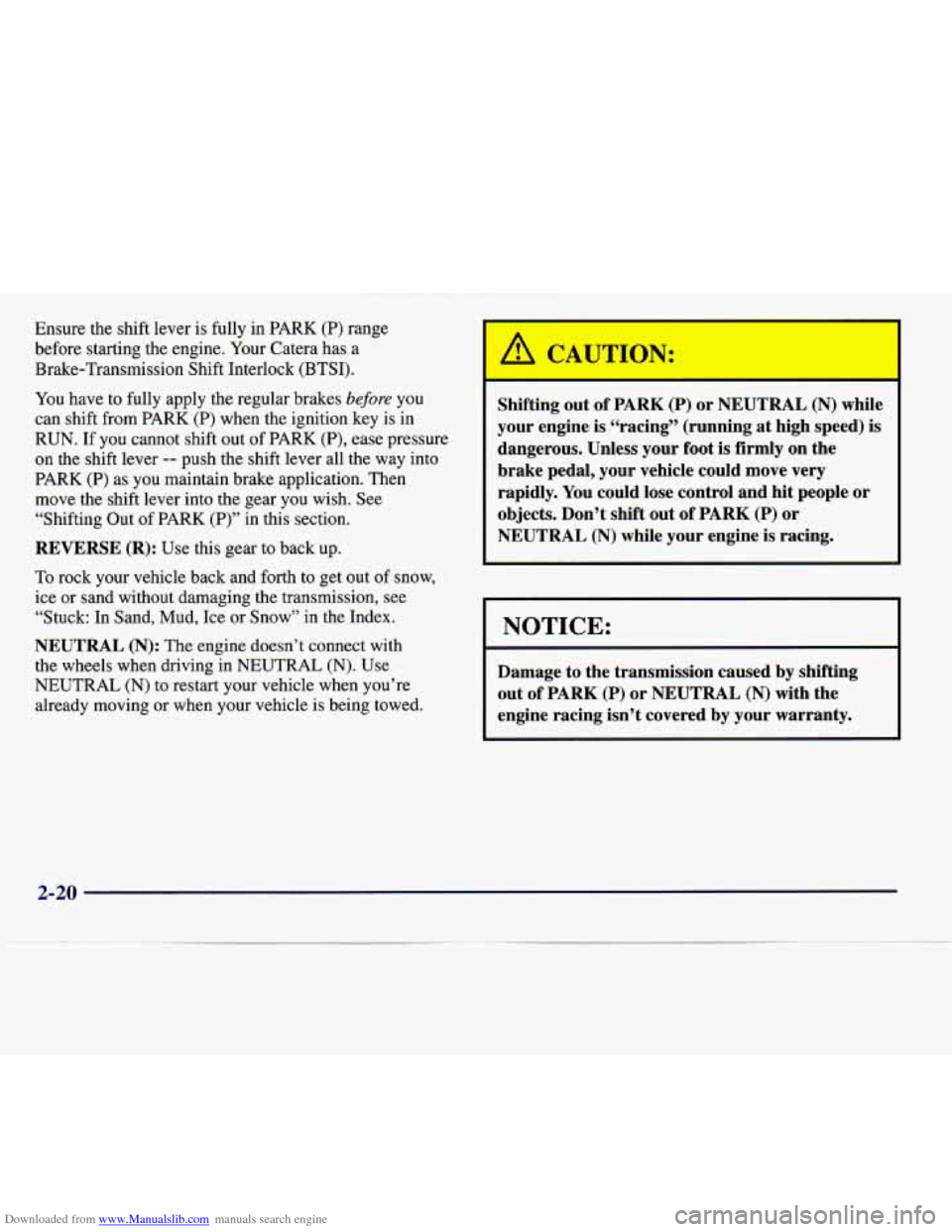
Downloaded from www.Manualslib.com manuals search engine Ensure the shift lever is fully in PARK (P) range
before starting the engine. Your Catera has a
Brake-Transmission Shift Interlock (BTSI).
You have to fully apply the regular brakes
before you
can shift from PARK
(P) when the ignition key is in
RUN. If you cannot shift out of PARK (P), ease pressure
on the shift lever -- push the shift lever all the way into
PARK
(P) as you maintain brake application. Then
move the shift lever into the gear you wish. See
“Shifting Out of PARK
(P)” in this section.
REVERSE (R): Use this gear to back up.
To rock your vehicle back and forth to get out of snow,
ice or sand without damaging the transmission, see
“Stuck: In Sand,
Mud, Ice or Snow” in the Index.
NEUTRAL (N): The engine doesn’t connect with
the wheels when driving in NEUTRAL
(N). Use
NEUTRAL
(N) to restart your vehicle when you’re
already moving or when your vehicle is being towed.
I 1
Shifting out of PARK (P) or NEUTRAL (N) while
your engine
is “racing” (running at high speed) is
dangerous. Unless your foot is firmly on the
brake pedal, your vehicle could move very
rapidly. You could lose control and hit people or
objects. Don’t shift out of
PARK (P) or
NEUTRAL (N) while your engine is racing.
NOTICE:
Damage to the transmission caused by shifting
out of PARK
(P) or NEUTRAL (N) with the
engine racing isn’t covered by your warranty.
2-20
Page 82 of 338
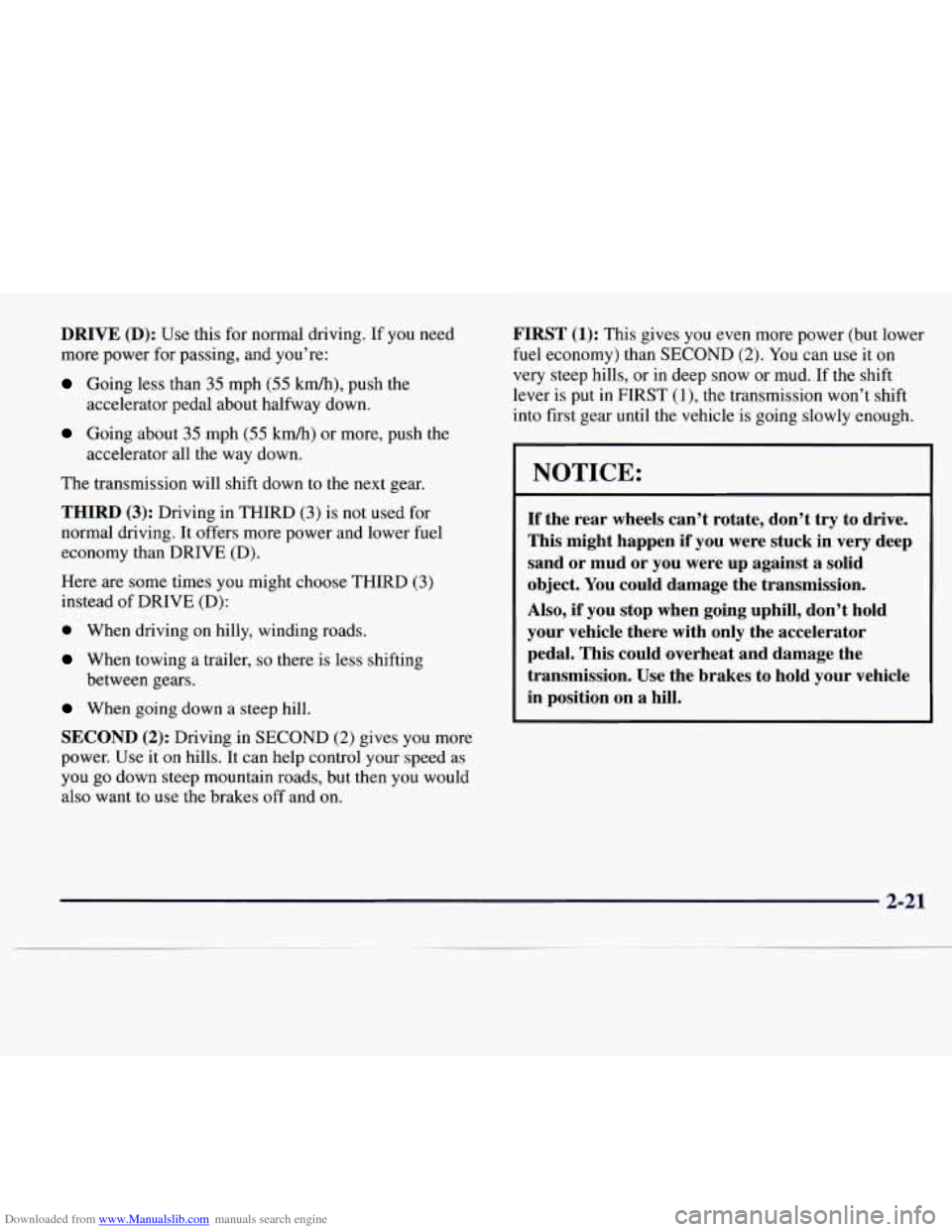
Downloaded from www.Manualslib.com manuals search engine DRIVE (D): Use this for normal driving. If you need
more power for passing, and you’re:
Going less than 35 mph (55 kmh), push the
Going about 35 mph (55 km/h) or more, push the
The transmission will shift down to the next gear.
THIRD (3): Driving in THIRD (3) is not used for
normal driving.
It offers more power and lower fuel
economy than DRIVE (D).
accelerator pedal about halfway down.
accelerator all the
way down.
Here
are some times you might choose THIRD (3)
instead of DRIVE (D):
0 When driving on hilly, winding roads.
When towing a trailer, so there is less shifting
between gears.
When going down a steep hill.
SECOND (2): Driving in SECOND (2) gives you more
power. Use
it on hills. It can help control your speed as
you go down steep mountain roads, but then you would
also want to use the brakes
off and on.
FIRST (1): This gives you even more power (but lower
fuel economy) than SECOND
(2). You can use it on
very steep hills, or
in deep snow or mud. If the shift
lever is put
in FIRST (l), the transmission won’t shift
into first gear until the vehicle is going slowly enough.
NOTICE:
If the rear wheels can’t rotate, don’t try to drive.
This might happen
if you were stuck in very deep
sand or mud or you were up against a solid
object. You could damage the transmission.
Also, if you stop when going uphill, don’t hold
your vehicle there
with only the accelerator
pedal. This could overheat and damage the
transmission. Use the brakes to hold your vehicle
in position on a hill.
2-21
-
Page 85 of 338
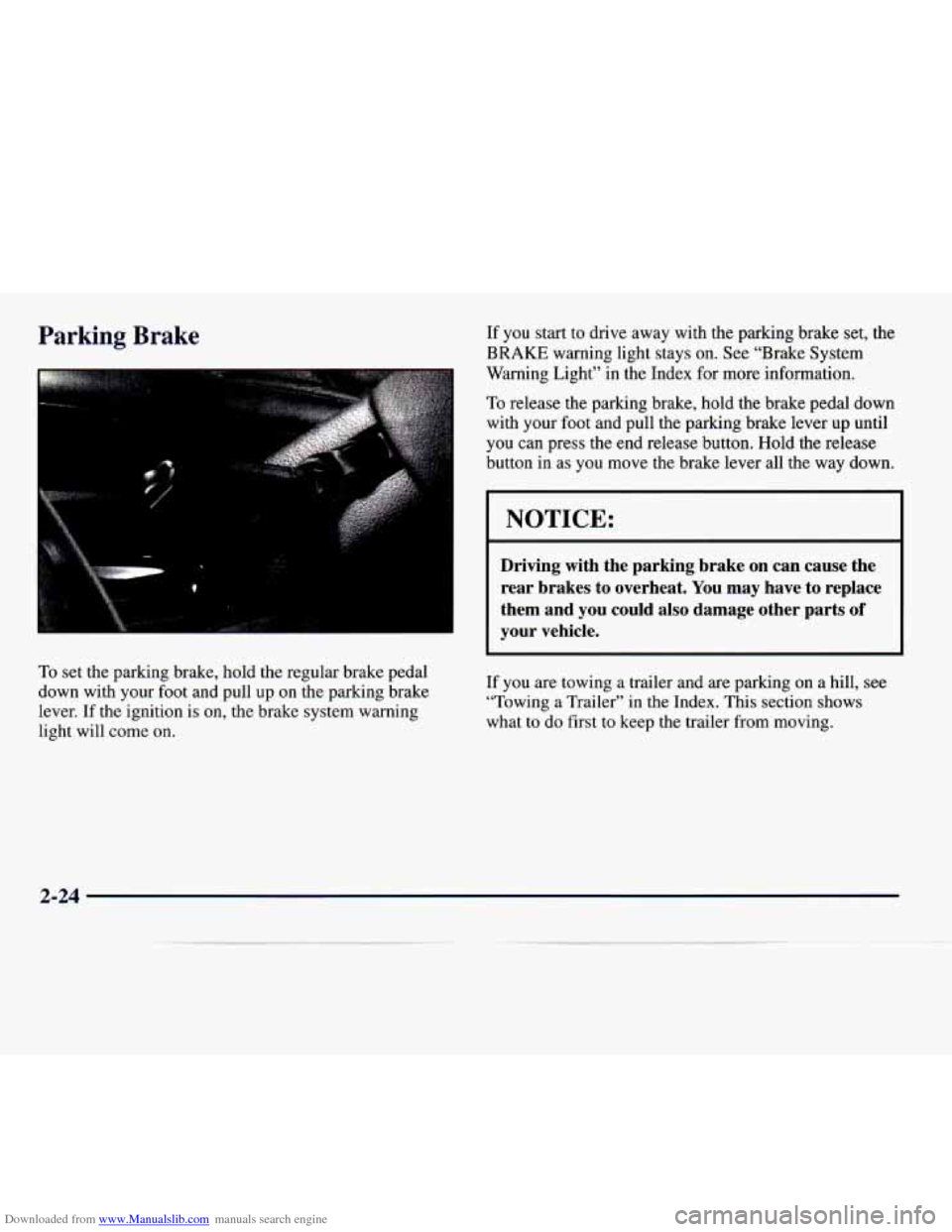
Downloaded from www.Manualslib.com manuals search engine Parking Brake If you start to drive away with the parking brake set, the
BRAKE warning light stays on. See "Brake System
Warning Light" in the Index for more information.
To release the parking brake, hold the brake pedal down
with your foot and pull the parking brake lever up until
you
can press the end release button. Hold the release
button in as
you move the brake lever all the way down.
1 .. .
0
NOTICE:
Driving with the parking brake on can cause the
rear brakes to overheat. You may have to replace
them and you could also damage other parts
of
your vehicle.
To set the parking brake, hold the regular brake pedal
down with your foot and pull
up on the parking brake
lever.
If the ignition is on, the brake system warning
light will come on. If you
are towing a trailer and
are parking on a hill, see
"Towing a Trailer" in the Index. This section shows
what to do first to keep the trailer from moving.
2-24
Page 86 of 338
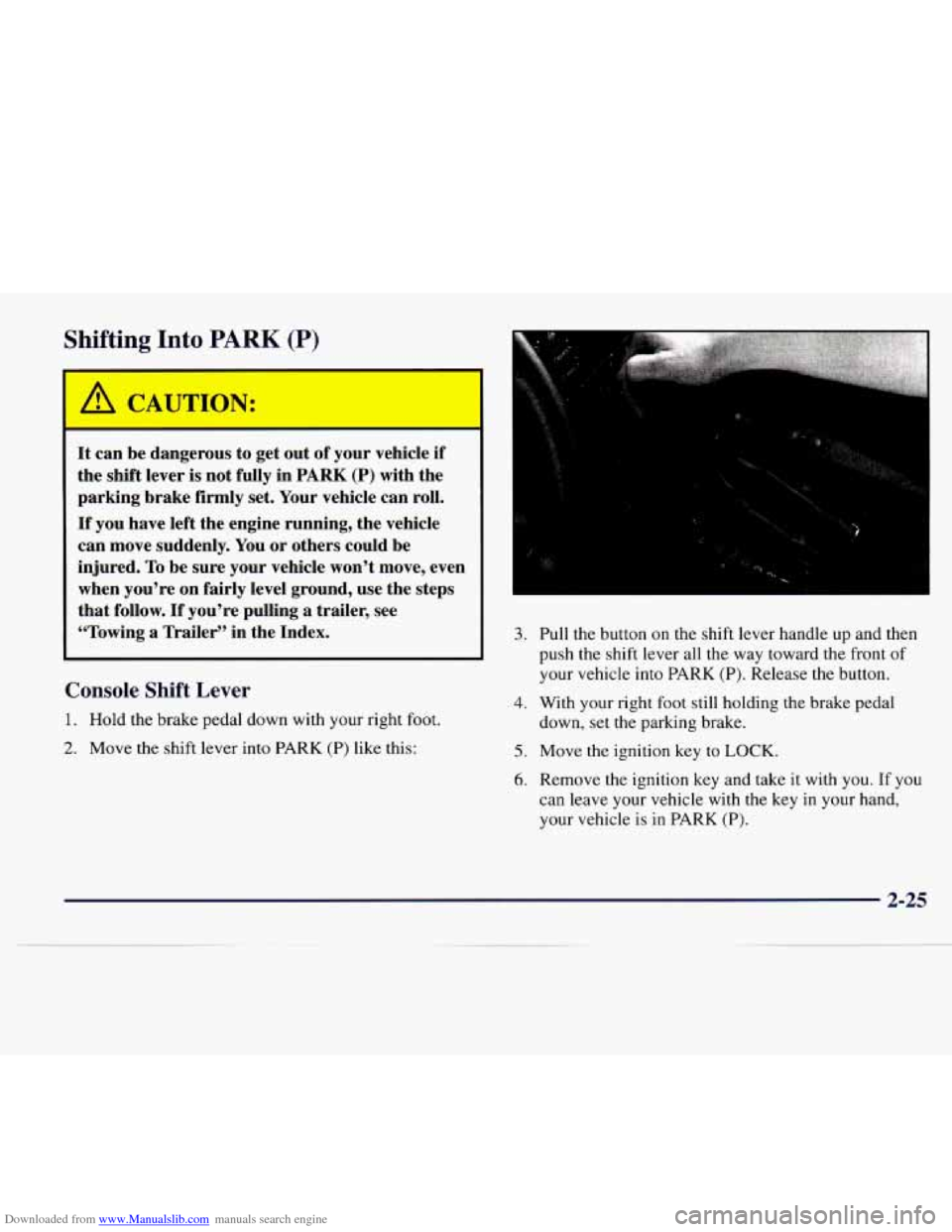
Downloaded from www.Manualslib.com manuals search engine Shifting Into PARK (P)
It can be dangerous to get out of your vehicle if
the shift lever is not fully in
PARK (P) with the
parking brake firmly set. Your vehicle can roll.
If you have left the engine running, the vehicle
can move suddenly. You or others could be
injured.
To be sure your vehicle won’t move, even
when you’re on fairly level ground, use the steps
that follow.
If you’re pulling a trailer, see
“Towing
a Trailer” in the Index.
Console Shift Lever
1. Hold the brake pedal down with your right foot.
2. Move the shift lever into PARK (P) like this:
..
3. Pull the button on the shift lever handle up and then
push the shift lever all the way toward the front of
your vehicle into PARK
(P). Release the button.
4. With your right foot still holding the brake pedal
down, set the parking brake.
5. Move the ignition key to LOCK.
6. Remove the ignition key and take it with you. If you
can leave your vehicle with the key in your hand,
your vehicle is
in PARK (P).
2-25
Page 87 of 338
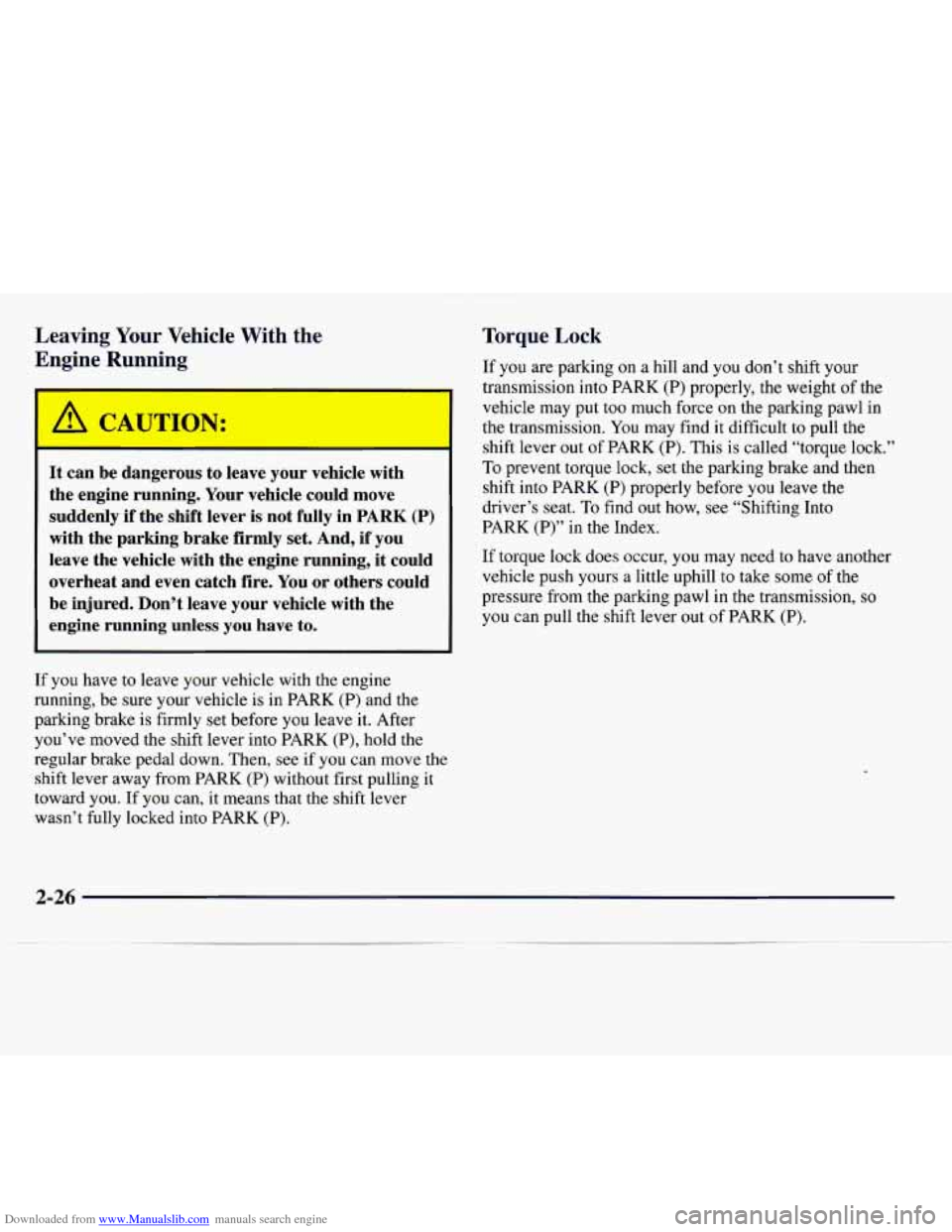
Downloaded from www.Manualslib.com manuals search engine Leaving Your Vehicle With the
Engine Running
It can be dangerous to leave your vehicle with
the engine running. Your vehicle could move
suddenly if the shift lever is not fully in
PARK (P)
with the parking brake firmly set. And, if you
leave the vehicle with the engine running, it could
overheat and even catch fire. You or others could
be injured. Don’t leave your vehicle with the
engine
running unless you have to.
L
Torque Lock
If you are parking on a hill and you don’t shift your
transmission into PARK (P) properly, the weight
of the
vehicle may put too much force on the parking pawl
in
the transmission. You may find it difficult to pull the
shift lever out of PARK
(P). This is called “torque lock.”
To prevent torque lock, set the parking brake and then
shift into PARK
(P) properly before you leave the
driver’s seat.
To find out how, see “Shifting Into
PARK
(P)” in the Index.
If torque lock does occur, you may need to have another
vehicle push yours
a little uphill to take some of the
pressure from the parking pawl in the transmission,
so
you can pull the shift lever out of PARK (P).
If you have to leave your vehicle with the engine
running, be sure your vehicle is in PARK (P) and the
parking brake is firmly set before you leave it. After
you’ve moved the shift lever into PARK
(P), hold the
regular brake pedal down. Then, see if you can move the
shift lever away from PARK
(P) without first pulling it
toward you. If you can, it means that the shift lever
wasn’t fully locked into PARK (P).
2-26